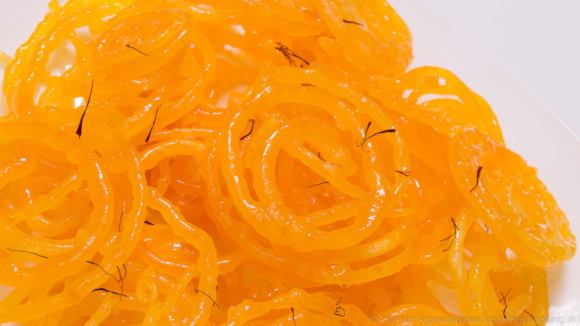Mama’s Punjabi Recipes: Jalebi (FRIED SWEET FLOUR SPIRALS)
 Talk to a Punjabi about jalebis (sweet flour spirals) and he will immediately mention hot milk to go with it! Jalebis are a dish adopted from the Persians, but now so Indianized that it is claimed as our own. Below is a reprint of Mama’s Jalebi recipe, which is a tasty sweet seldom found in Indian restaurants. It is reprinted with some additional information and directions.
Talk to a Punjabi about jalebis (sweet flour spirals) and he will immediately mention hot milk to go with it! Jalebis are a dish adopted from the Persians, but now so Indianized that it is claimed as our own. Below is a reprint of Mama’s Jalebi recipe, which is a tasty sweet seldom found in Indian restaurants. It is reprinted with some additional information and directions.
Some dishes that originated in Northern India have been so widely accepted that they are available all around the country now, especially the sweet desserts. Gulab jamun (fried rose colored ball); ras gullas (syrup soaked sponge balls); burfi (evaporated milk wedges); ladoos (chickpea flour balls) are just some of these. To this list, you must add jalebis, the delectable deep-fried, soft flour spirals.
You can find jalebis being made in a large kadai (wok) full of hot oil at any corner halwai’s (confectioner) shop in the evenings and many people will stop by to buy some piping hot ones to eat with their chai. Jalebis are especially popular at weddings and birthdays and during the Ramadan, Dusserah and Diwali seasons. They are really popular on cold, winter days when they are dipped in warm milk and devoured!
Jalebis are popular in other countries too, in the Middle East, Libya, Egypt, Iran, Africa and the Maldives. The dish was brought to India in the 15th century by Persian invaders, and is called zulbia in Farsi.
Although it may seem easy to make good jalebis, it is really an art of perfect flour mix; syrup consistency and timing to get them out of the deep-fry with the crunchy crispiness that makes chewing them a delight. It is one of the few dishes that require two people to make. If the jalebis are taken out too quickly, they become soft, limp and taste a little mushy. During the festival season, it is best to make some extra chasni (syrup) and keep it aside for quick use in making jalebis.
Ingredients:
• 2 cups maida – (bleached white flour)
• 2 cups chinni (sugar)
• 2 cups pani (water)
• Vegetable or sunflower oil for frying
• 1 tsp orange food coloring
• 1 tsp baking soda
• Small clean muslin or cotton cloth
Directions:
1. To make the chasni, pour the sugar into a wide saucepan, add the water and orange coloring and mix thoroughly with a spoon. Bring to a boil for 10 minutes then turn off the heat and keep to the side.
2. Mix in the water and baking soda into the maida so that the dough is a paste, but not runny.
3. Make a small ¼ inch hole in the cloth. Pour some dough paste in the middle, then fold the cloth around it in the shape of a fat ball.
4. Heat the oil on high in the kadai and when hot, squeeze some of the paste in from the cloth in spirals till the surface is full.
5. The other person should quickly take the fried spirals out once it is a golden color. The first person then squeezes out more dough into the hot oil to repeat the process.
6. Dip the hot spirals into the chasni and after 1 minute, take them out with a strainer to drip.
7. Break into smaller spirals and serve hot with milk or chai.
MAMA’S TIP OF THE WEEK: FOR FASTER JALEBIS, USE BAKING POWDER
Jalebis taste really good if they are fresh, fluffy, light and crisp; almost like a fried light wafer. Their crunchiness is an important part of the experience of eating jalebis, but if there are large pieces of flour lumped together, then these taste soft and chewy.
The trick is to make the batter fluffy, and to do this quickly, it is necessary to add some baking soda when the paste is being made. The other way is organic but requires better preparation. Mix the paste without the baking soda and then let it set in a warm spot, like inside the oven, for two days. It will rise by itself and be naturally light.

Shakuntla Malhotra is a skilled cook of Punjabi dishes made in the old-fashioned style that she learnt as a young woman in her ancestral home in Lyallpur, India (since renamed Faisalabad) before it became part of Pakistan after the Partition in 1947. People have often admired her cooking for its simplicity and taste that comes with each mouthful. Even in her late-eighties, she continues to cook daily and agreed to share her delectable Punjabi recipes for future generations.
